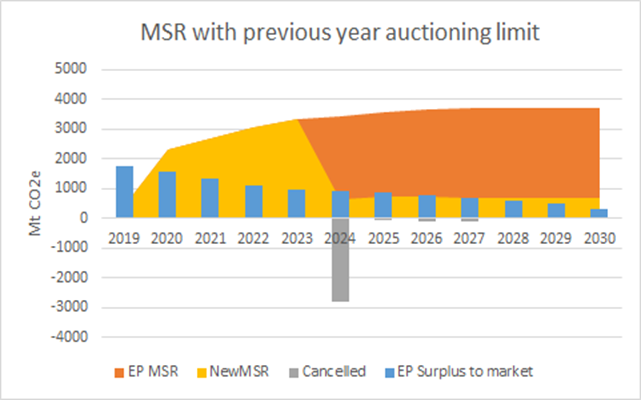On Tuesday, 28 February 2017, the Environment Council agreed on a general approach on the revision of the EU Emission Trading Scheme (ETS). Although the agreement goes further in terms of ambition than the European Parliament’s position adopted on 15 February, it still falls dramatically short of delivering the reform needed to align the ETS with the Paris Agreement.
The main mechanism to boost the level of ambition of the reform adopted by the Council concerns an annual cancellation of allowances in the Market Stability Reserve. It has only limited impact in the 4th trading period until 2030, but will remove around 3 billion surplus allowances which will have positive impacts in the long term.
The revision of the ETS will now be negotiated in trialogue meetings between the Parliament, the Council and the Commission.
Summary of the Council’s general approach
AMBITION
In terms of raising the overall ambition of the ETS:
- The Council decided on an annual cancellation mechanism for allowances in the Market Stability Reserve (MSR) which will take effect in 2024. It puts a cap on the allowances banked in the MSR equivalent to the total number of auctioned allowances in the previous year. All allowances exceeding this threshold will be cancelled. This measure only has limited impact in the 4th trading phase and offers more of a long term improvement. Tt could, depending on actual emissions, cancel over 3 billion allowances by 2030 (the sum of the grey bars in the graph below). Although conditional on a review, this amendment tabled by the Czech delegation and supported by a coalition of France, Luxembourg, the Netherlands and Sweden was the biggest gain in terms of ambition in the Council’s position.
(Not included in Parliament position)

Note: Estimates by Sandbag. Assuming a 57% share of auctioned allowances and conditional on actual level of emissions. Change in auctioning share (to 55% as currently proposed) likely to have only minor impacts.
- The intake rate for the Market Stability Reserve will be doubled for the first five years of its operation from 12% to 24%.
(One year more than Parliament suggested) - The Council wants to maintain the Linear Reduction Factor (LRF) at 2.2%. Raising the reduction rate of the cap would have sent a strong signal that Member States are willing to realign the ETS cap with the Paris agenda.
(Parliament suggested potential raise to 2.4 from 2024 onwards) - The Council did not consider readjusting the starting level in 2021 to actual emissions. This could have eliminated up to 2.4 billion tonnes of surplus allowances with an immediate substantial impact on the carbon price, which currently lingers at a dramatic 4 to 5 euros per tonne of CO2.
(Also rejected in Parliament) - The Council did not include a provision granting Member States the option to cancel allowances if they wish to do so.
(Included in Parliament position)
CARBON LEAKAGE (free allowances for industry):
- The Council agreed to lower the auction share by 2% to 55%. This means an increase in the share of free allowances for industries to 45%. There is still no evidence for ETS-induced carbon leakage. Thus, the ETS should move towards 100% auctioning share.
(Parliament position even worse: includes potential lowering to 52%) - The Council also supports the proposed measures on compensation of indirect costs. Member States would then be able to use up to 25% of auctioning revenues to compensate companies claiming to be exposed to carbon leakage. We are against indirect cost compensation because it is another subsidy for energy intensive industry.
(Also included in the Parliament’s position, but limited to 20%)
FUNDS AND REVENUES:
- The Council has granted Greece a very special access to the Modernization Fund (10d). In particular, it offered Greece 20 million unallocated allowances to invest in its island interconnections. Even if the final text of the revised directive has no EPS as an investment criterion for the Modernization Fund, this particular phrasing for Greece guarantees that this money cannot be used for retrofits of lignite plants.
(Parliament changed base year which would include Greece, but neither specifies amount nor earmarks purpose of revenue) - On art. 10c and and art. 10d no eligibility criteria were added (including no EPS) to the Commission’s proposal despite number of countries voicing need for those.
(Included in Parliament position) - Art.10c – threshold for the projects taking part in the competitive bidding process was increased to 15 mln EUR (from 10 mln EUR). Projects not going through the bidding process would be selected by Members States.
(10 mln EUR in Parliament position) - Art. 10d- Council agreed on a stronger governance of the Modernization Fund, that includes European Investment Bank involvement.
(In line with Parliament position)
Next step: Trialogue
The proposal now moves to the informal trilogue process in which representatives of the European Commission, the European Parliament rapporteur and shadow rapporteurs and representatives of the Maltese Council Presidency aim to find agreement on the conflicting elements before the file goes back to the European Parliament for second reading and the Council for qualified majority voting.
Stocktake of Parliament position
Although the overall outcome of the Parliament’s position is a clear disappointment, some amendments are worth defending against the Council’s position, while others should be withdrawn from the proposal:
Elements not in the Council mandate but adopted by the Parliament to be supported:
- Potential raise of the Linear Reduction Factor (LRF) to 2.4% in 2024. Though not as ambitious and timely as would be desirable, the Parliament included a possible increase of the LRF during the next trading phase, as part of the Paris review. Raising the rate of annual reductions would send a strong signal that the institutions are trying to put the ETS on a Paris-consistent pathway.
- Market Stability Reserve (MSR) design:
- Cancelling 800 million allowances from the MSR. This one off cancellation is compatible with the annual cancellation mechanism from the Council and both should be supported.
- Doubling the MSR intake rate from 12 to 24% of surplus emissions for four years starting in 2019.
- Member States should have the option to cancel allowances if they wish to do so. This could decrease the surplus but only if a large enough number of Member States decide to do so with a significant number of their allowances.
- Creation of Just Transition Fund, operational as of 2021 to support transformation regions with a high share of workers in carbon-dependent sectors and a GDP per capita well below the Union average.training initiatives to re-skill workers in carbon-dependent sectors with a below-average GDP. It would be funded by pooling 2% of auctioning revenues.
- An emissions performance standard (EPS) of 450 gCO2/kWH eligibility criterion for projects funded through both art.10c and the Modernization Fund needs to be maintained, which practically excludes investments in coal and biomass co-firing plants.
- Maintaining strong governance of the Modernization Fund that includes European Investment Bank involvement.
- Strengthening details of aviation in the ETS and including shipping via an EU Maritime Climate Fund.
- A review process (Commission communication ahead of facilitative dialogue in 2018 and a report ahead of the global stocktake in 2023) to assess whether the EU ETS is in line with the Paris Agreement goals.
Elements not in the Council mandate but adopted by the Parliament to be opposed:
- More free allowances for steel industry due to a special provision granted to waste gases and due to the exclusion from the application of the cross-sectoral correction factor.
Stocktake of Council’s general approach
On the side of the Council, notably the proposal concerning the cancellation of allowances in the MSR should be secured during the upcoming Trilogue, while in some cases the Council exacerbated existing elements.
Elements of Council mandate but not adopted by Parliament to be supported:
- Market Stability Reserve (MSR) design:
- Annual mechanism to cancel allowances in the MSR as of 2024. This measure could cancel up to 3 bn allowances in the long term.
- Five year doubling of the MSR intake rate from 12 to 24% starting in 2019.
Elements of Council mandate but not adopted by Parliament to be opposed:
- 25% limit to use auctioning revenue for domestic indirect cost compensation. The Parliament supposes a slightly more stringent ceiling of 20%.
- Increasing the art. 10c investment threshold to participate in the competitive bidding process to 15 mln EUR. Commission and Parliament set the threshold to 10 mln EUR.
Overview Table
The following table indicates each institution’s position per topic. Green cells refer to elements to be supported during the trilogue while red positions should be objected. However, one needs to keep in mind that the overall proposal (including all ambitious elements which at this stage still remain on the table) remain insufficient to deliver an ETS reform coherent with the Paris Agreement.
|
|
EP Position |
Council General approach |
||
|
Ambition |
Doubling MSR intake rate |
|
|
|
|
MSR annual cancellation |
|
|
||
|
MSR 800 mln |
|
|
||
|
LRF increase |
|
|
||
|
Unilateral cancellation by MS |
|
|
||
|
Review clause |
|
|
||
|
Carbon leakage
|
Share of auctioned allowances |
|
Not good, only less bad |
|
|
Indirect cost compensation |
Not good, only less bad |
|
||
|
Waste gases |
|
|
||
|
Funds |
EPS for 10c |
|
|
|
|
EPS for Modernisation Fund |
|
|
||
|
Modernisation Fund |
|
|
||
|
Just Transition Fund |
|
|
||
|
Other |
International aviation |
|
|
|
|
International shipping |
|
|
||



